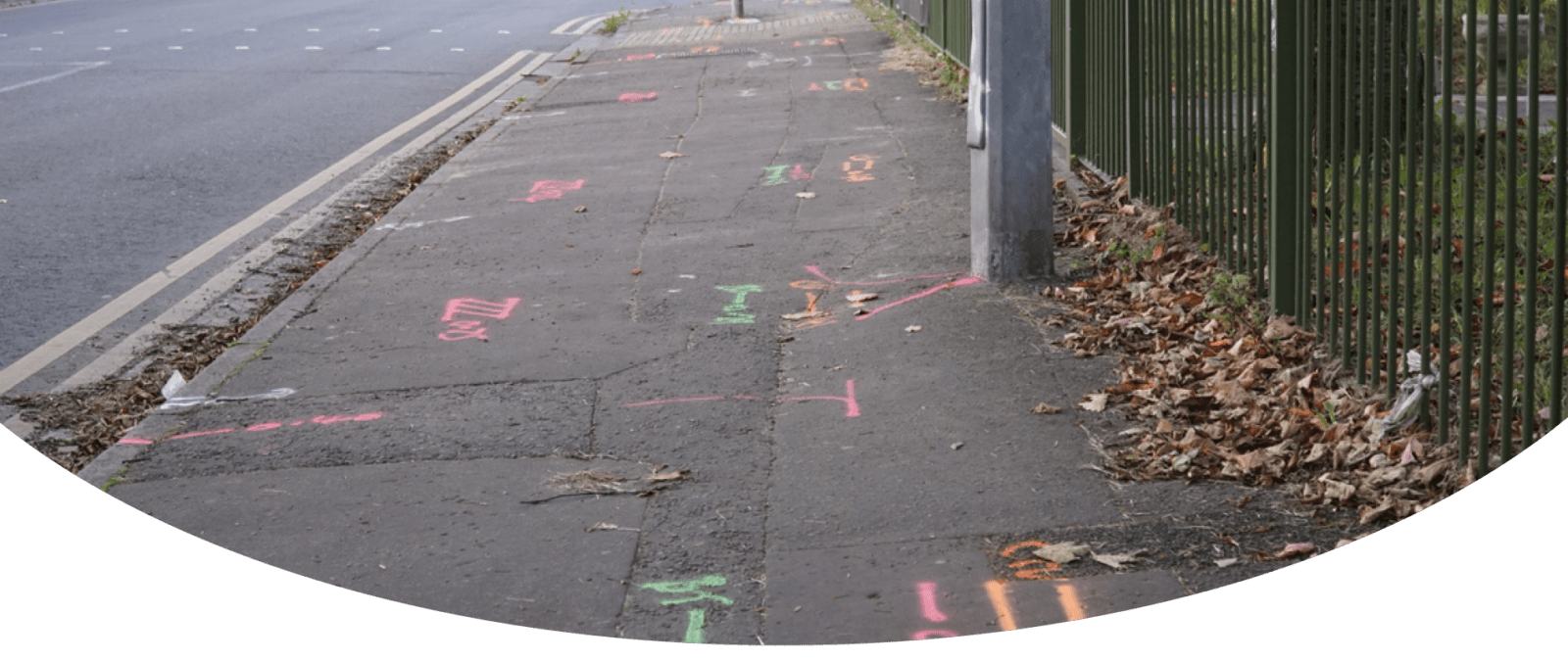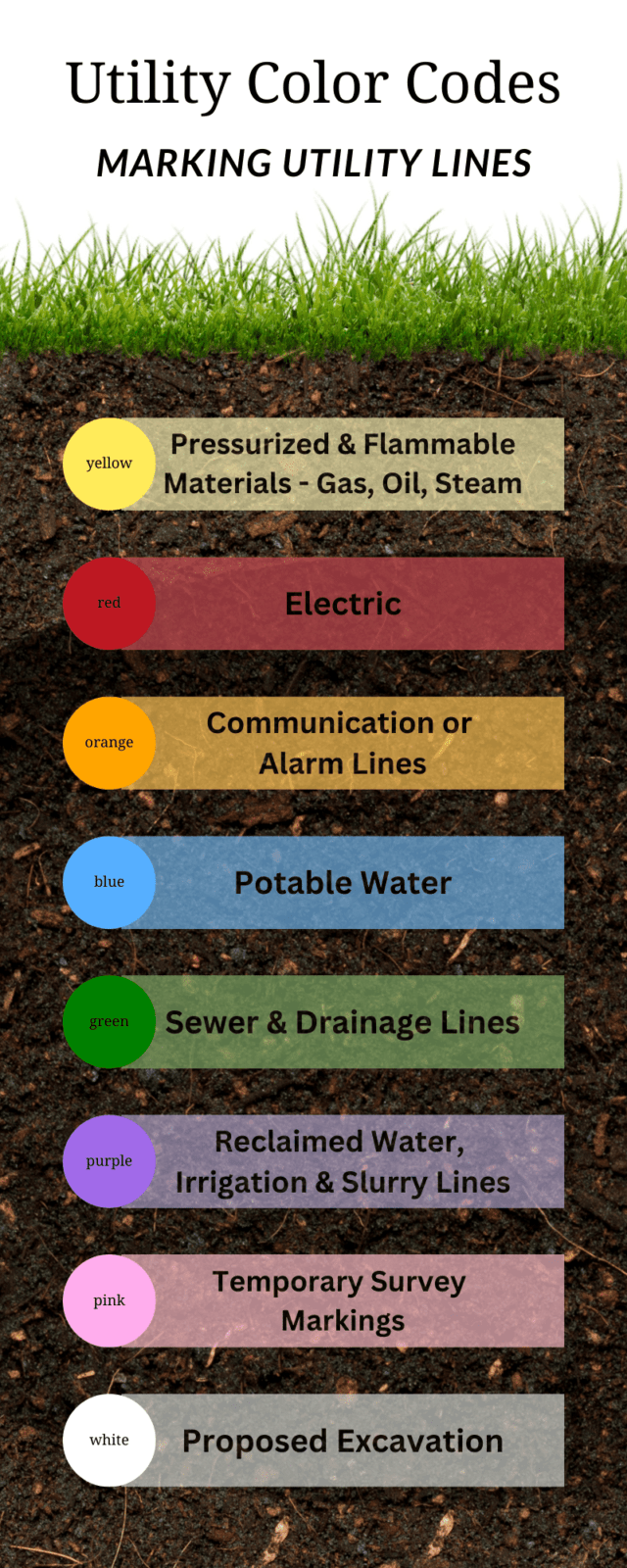
On a beautiful June day in Southern California in 1976, construction workers accidentally cut through a petroleum pipeline that was under pressure, not realizing that it was located there. The resulting explosion leveled half a city block in Culver City, and dozens of people were injured or killed due to the explosion and the damage that it caused.
Shortly after this disaster took place, California was the first state to establish a system to track where utilities were buried, called the DigAlert system. By contacting the office, construction firms could find out exactly where utilities were buried to avoid another disaster in the future. Many other states got on board, and as part of this movement, the American Public Works Association created the Utility Color Codes standard, which was later adopted as ANSI Safety Color Code Z535.
This standard makes it much easier for contractors to understand what is represented by safety colors laid down with spray paint or flags to mark the route of a utility’s path. Additional information can also be placed on the site that will tell the type of utility facility contained therein, the direction to the utility, the type of material used, and similar details. In this article, we’ll discuss the basics of utility color codes, including how the Common Ground Alliance is helping make it even easier for a utility member to understand what is being designated at a construction area.
The Uniform Color Code indicates how utility lines are marked during a locate request, whether it’s by another utility company making the request or a construction business. Specific colors, symbols, and abbreviations are used to indicate what is located where, so that when undertaking excavation work, the crew can avoid potentially hazardous situations, either by cutting into existing lines or placing lines that should not be located near other utilities.
What is underground utility construction? When construction happens in larger cities, many of the utilities are buried to prevent damage due to wind storms, downed trees, and similar hazards. However, this leaves a large web of unseen infrastructure that brings power to homes, businesses, traffic signals, and public lighting, as well as flammable gas or chemicals to a wide range of locations, communications lines that transmit phone calls and internet searches, water mains to homes, businesses, and parks, and finally, drain lines to remove sewage and storm water away from these locations.
Given the prevalence of these many underground utilities, it’s easy to understand why having uniform safety standards in place is so important. That’s why when a locate request is issued, the utility facility owner will go out and mark the ground to prevent damage to their underground utilit
y lines and a high repair cost. However, in addition to the colors used to create temporary markings of the utility routes, there is also a range of other notations that can indicate important information, such as underground facilities so that work crews can work effectively, which we’ll cover later in this article.

Yellow – Utility lines marked with this color can contain a number of pressurized and/or flammable materials, including natural gas, petroleum products, oil, steam, or related liquid or gaseous materials.
Red – This color has to do with electricity, whether it’s buried electric power lines, cables, conduits, lighting cables, and traffic signal lines, to name a few.
Orange – The color orange indicates a range of communication lines, which can include fiber optic, cable television, alarm lines, telephone lines, or other underground lines for communication purposes.
Blue – When you see blue lines on the ground, this indicates that there are potable water mains or lines located below, which can cause serious problems in your construction area.
Green – If you see a green line as a temporary marking of underground utilities, steer clear! Green indicates sewer lines, drain lines, storm drain lines, or similar drainage facilities or piping.
Purple – If you have a big push for recycling greywater, industry, or agriculture in your area, you may run across purple lines, which indicate reclaimed water, irrigation, and slurry lines.
Pink – Pink lines indicate temporary survey markings, making it easier for your construction or utility team to locate specific areas based on the survey, so be careful to keep them in place.
White – White lines are the extent of your site’s proposed excavation limits, making it much easier to determine where existing underground utilities will impact your excavation process.
Arrows show where the utility enters and exits your site, or can also be used to show the direction to an underground facility. These make it easier to determine the extent of the utility on your site, so that you can include it for future phases or additional growth.
Dots or circles with an X in the middle may indicate an underground utility function that you’ll possibly want to retain access to, such as a valve, splice, or manhole. Larger structures, such as vaults, will often be outlined with a dashed line. A circle with a line through it (Do Not) signifies that the utilities there do not conflict with specific other utilities, such as a water line not conflicting with gas lines. Two lines with a diamond between them indicate a conduit, while an H shape indicates a corridor marking. Oversize utilities will have an H shape with a third upright, and a series of letters and numbers to indicate type and size.
Letters are very commonly used, especially as abbreviations:
Start by training your employees and contractors about the underground infrastructure in your area as pertains to public safety (p.s.). Encourage them to use hand tools around particularly sensitive pieces of infrastructure to avoid a serious accident or disaster from occurring. Creating a “cheat sheet” of what different colors, markings, and letters mean and posting several copies around the construction area makes it easier for them to keep up with what the markings mean, beyond a simple horizontal line on the pavement.
Maintaining accurate records is also very important and it allows you to know exactly where your structure has overlapped with existing infrastructure should an underground project need to take place in the future. If any changes or rerouting is needed, make sure to update on your architectural drawings exactly what has been changed, in what way, and to what extent.
Periodic inspection of markings on your job site can help prevent accidents, especially if you have a long-term project or severe weather in the area. If you find during an inspection that the temporary marking of underground utilities has begun to fade, become faint, or otherwise has become difficult to read, you may want to touch up the lines with spray paint or fresh flags to ensure that the location is sustained throughout your construction area.
By following these steps, you can avoid many accidents and disasters on your job site, as well as an expensive repair cost bill from the utility. When your crew understands what all that spray paint on the ground means, they’re more likely to take appropriate steps to prevent damage. Accurate records can prevent accidents down the road, as everyone who needs to will know where underground utilities are located on your site. Regular inspection and reapplication of markings help avoid acciden
ts caused when your crew doesn’t realize that there’s a utility beneath their feet that has had its markings washed away.
Because codes can vary greatly from one location to the next, it’s important to check with your city, county, regional, and state codes to determine at what point you have a legal requirement to use utility color codes on your construction area. This will help you determine what your legal responsibilities are for the markings on your construction site.
In the Maryland, Delaware and DC area, a company called Miss Utility manages local underground utility marking. If you are doing any excavation work, down to digging in your backyard, it’s legally required that you inform Miss Utility at least 48 hours in advance. This allows each facility owner-members to confirm that the lines are marked or are outside the work area. Miss Utility’s goal is to prevent injury, loss of life, environmental damage, and interruptions to vital services because of excavation damage as it can be very dangerous to dig.
These legal codes, locally and federally, keep utility construction and excavation safe for the surrounding communities. It is crucial to familiarize yourself with the legal requirements, managing organizations such as Miss Utility, and standard practices before engaging in underground utility construction.
National Capital has extensive experience helping contractors around the Washington, D.C. area, and understands what different agencies may require when performing work. If you need help finding the right solutions for your construction area or you need any equipment for your project, our team is ready to help. We offer construction safety equipment for rent or purchase. Contact us today with any questions or concerns about your project.